Tests with sketches
You should recall that the business wants our application to support both mobile and web clients and we already have some sketches of mobile and web UI. In this section we will modify our NOP/Pending tests to use the sketches as "screenshots".
To achieve that we will use SketchWebDriver instances to instruct the WebTest framework to use sketches from annotations as screenshots.
Tests refactoring
Base class
Because we will need to provide screenshots for web and mobile, we will convert our tests to parameterized tests.
And to avoid code duplication, we will define a base class for our tests by making a copy of NasdanikaBankRouteTest and adjusting it to our needs:
package org.nasdanika.bank.tests;
import static org.junit.Assert.fail;
import java.util.ArrayList;
import java.util.Collection;
import java.util.List;
import org.junit.After;
import org.junit.Before;
import org.junit.FixMethodOrder;
import org.junit.runner.RunWith;
import org.junit.runners.MethodSorters;
import org.junit.runners.Parameterized.Parameter;
import org.junit.runners.Parameterized.Parameters;
import org.nasdanika.bank.ui.driver.actors.NasdanikaBankActorFactory;
import org.nasdanika.webtest.ActorFactory;
import org.nasdanika.webtest.NasdanikaParameterizedWebTestRunner;
import org.nasdanika.webtest.WebTest;
import org.nasdanika.webtest.WebTestUtil;
import org.openqa.selenium.WebDriver;
/**
* Base class for tests. It handles driver creation and release.
* @author Pavel Vlasov
*
*/
@RunWith(NasdanikaParameterizedWebTestRunner.class)
@FixMethodOrder(MethodSorters.NAME_ASCENDING)
public abstract class NasdanikaBankTestBase implements WebTest<WebDriver> {
public enum DriverType {
sketch
// firefox,
// chrome,
// ie,
// phantomjs
}
public enum ClientType {
web,
mobile
}
@Parameters(name="{index}: {0}")
public static Collection<Object[]> getParameters() {
List<Object[]> ret = new ArrayList<>();
for (DriverType driverType: DriverType.values()) {
for (ClientType clientType: ClientType.values()) {
ret.add(new Object[] { driverType, clientType });
}
}
return ret;
}
@Parameter(0)
public DriverType driverType;
@Parameter(1)
public ClientType clientType;
@Override
public WebDriver getWebDriver() {
return driver;
}
private WebDriver driver;
@ActorFactory
public NasdanikaBankActorFactory actorFactory;
@Before
public void setUp() throws Exception {
switch (driverType) {
case sketch:
driver = WebTestUtil.createSketchWebDriver(driverType.name()+"/"+clientType.name());
break;
// case firefox:
// driver = new FirefoxDriver();
// driver.manage().timeouts().pageLoadTimeout(20, TimeUnit.SECONDS);
// break;
// case phantomjs:
// driver = new PhantomJSDriver();
// driver.manage().timeouts().pageLoadTimeout(20, TimeUnit.SECONDS);
// break;
default:
fail("Unsupported driver type: ");
}
}
@After
public void quitDriver() throws Exception {
if (driver!=null) {
driver.quit();
driver = null;
}
}
@Override
public long getScreenshotDelay() {
return 0;
}
}
This class defines two enumerations - DriverType and ClientType, which are used as test parameters.
The DriverType enumeration currently defines one value sketch, with other values commented out for future use.
The ClientType enumeration defines two values web and mobile.
getParameters() method returns a set of test vectors covering all possible permutations of DriverType and ClientType enumeration values.
As the system and a set of tests evolve, more parameters may be added, e.g. orientation and screen size, and more parameter values, e.g. different browser and mobile device drivers - Firefox, Chrome, IE, Appium for Android with different devices, Appium for iOS. Consequently, the number of all possible permutations will grow significantly and it might be wise to switch to combinatorial testing. For now, however, the exhaustive set of all possible parameter combinations is just what we need.
The setUp() method uses driverType and clientType parameter values to create
an instance of WebDriver. Currently it creates an instance of SketchWebDriver.
quitDriver() method quits the driver.
Add @Sketch Annotation
Once we have a base class for tests, we shall modify our tests to extend this base class and also
add Sketch annotations. The code snippet below shows the modified LogInTests class, other test classes were modified in similar fashion:
package org.nasdanika.bank.tests.guest;
import org.junit.Test;
import org.nasdanika.bank.tests.NasdanikaBankTestBase;
import org.nasdanika.webtest.Category;
import org.nasdanika.webtest.Link;
import org.nasdanika.webtest.Sketch;
import org.nasdanika.webtest.Title;
@Title("Log-in")
@Category("Guest")
@Link(
type = "Story@urn:org.nasdanika.story",
value = "org.nasdanika.bank.app/Bank.nasdanika_story#guest.log-in")
public class LogInTests extends NasdanikaBankTestBase {
@Test
@Title("Successful log-in")
@Sketch(
before="bundle://org.nasdanika.bank.app/sketches/guest-home-web.png",
after="bundle://org.nasdanika.bank.app/sketches/customer-home-web.png",
selector="sketch/web")
@Sketch(
before="bundle://org.nasdanika.bank.app/sketches/guest-home-mobile.png",
after="bundle://org.nasdanika.bank.app/sketches/customer-home-mobile.png",
selector="sketch/mobile")
@Link(
type = "Scenario@urn:org.nasdanika.story",
value = "org.nasdanika.bank.app/Bank.nasdanika_story#guest.log-in.successful-login")
public void successfulLogIn() throws Exception {
// Guest actor = actorFactory.createGuest(getWebDriver());
// NasdanikaBankPage page = actor.navigateToNasdanikaBankPage();
// Assert.assertNotNull(page); // TODO - implement assertions
}
}
Now the class extends NasdanikaBankTestBase and the test method has two @Sketch annotations - one for the web and the other for the mobile sketches.
Test results
After completing tests refactoring we re-run the tests and start the documentation system to browse the test results.
TOC
In the TOC tree we see a hierarchy of test parameters values with test method results are leaf nodes:
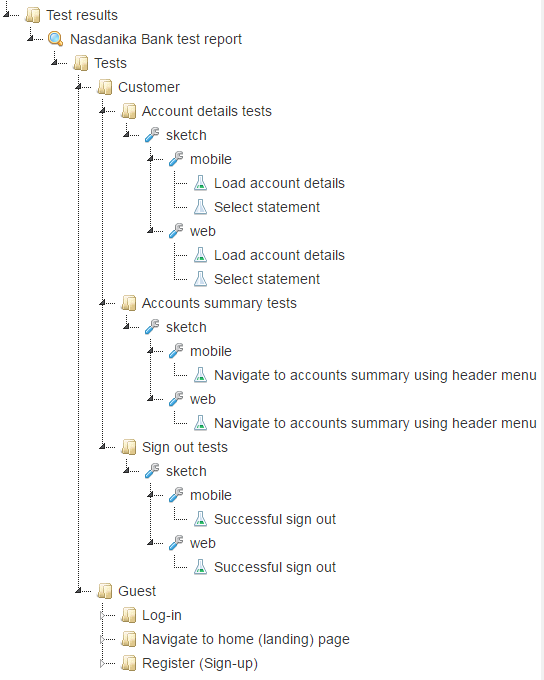
Test session
When we click on the test session we can see that we now have 14 tests, 10 passing and 4 pending:
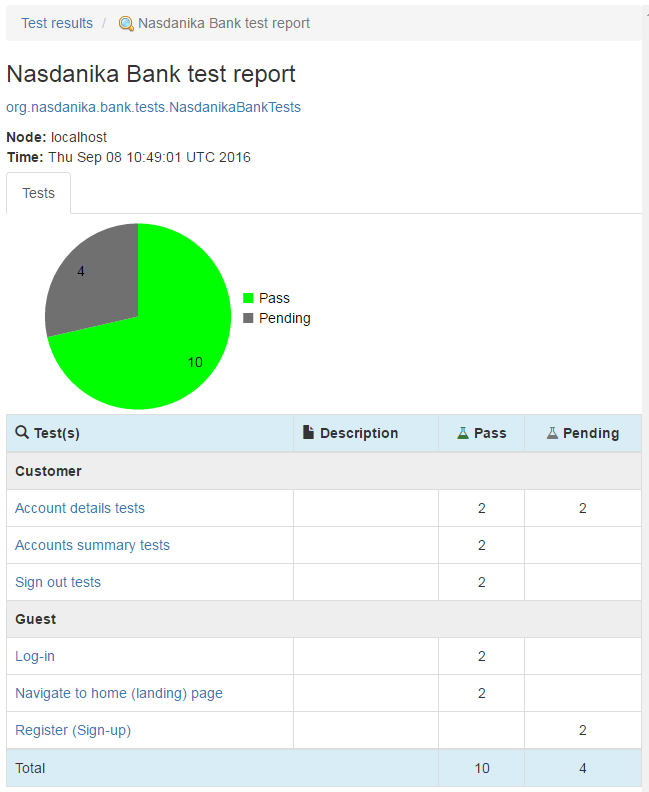
Parameterized test class
The Guest/Log-in test page shows test parameters, and a table with different parameter combinations:
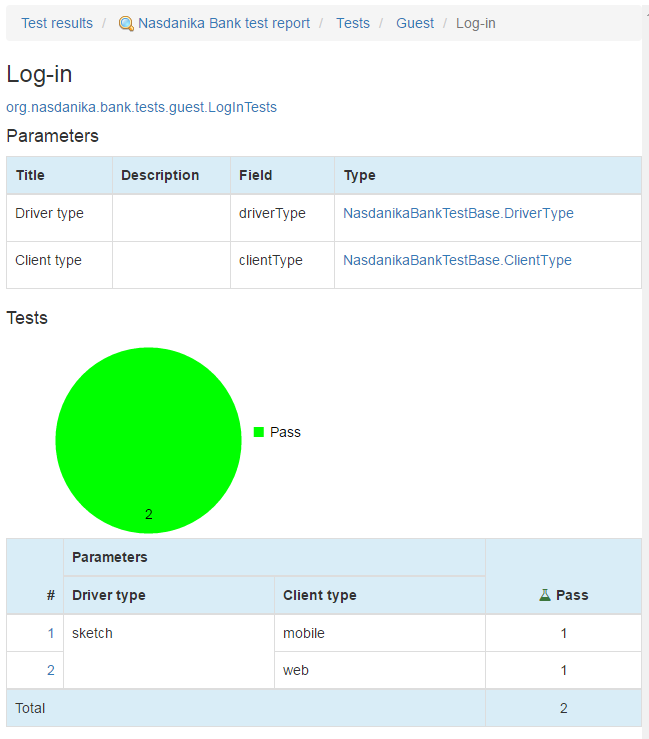
Parameters combination (test vector)
Click on the number 2 navigates to the test result page for the sketch, web parameters combination:
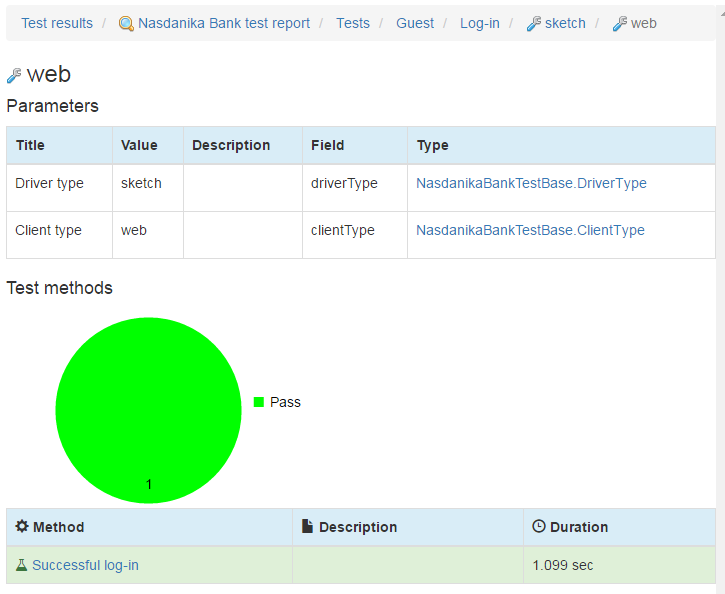
This page has a table of parameters with values, and a table of test methods, which we currently have only one.
Test method
Click on the method name opens the test method result page:
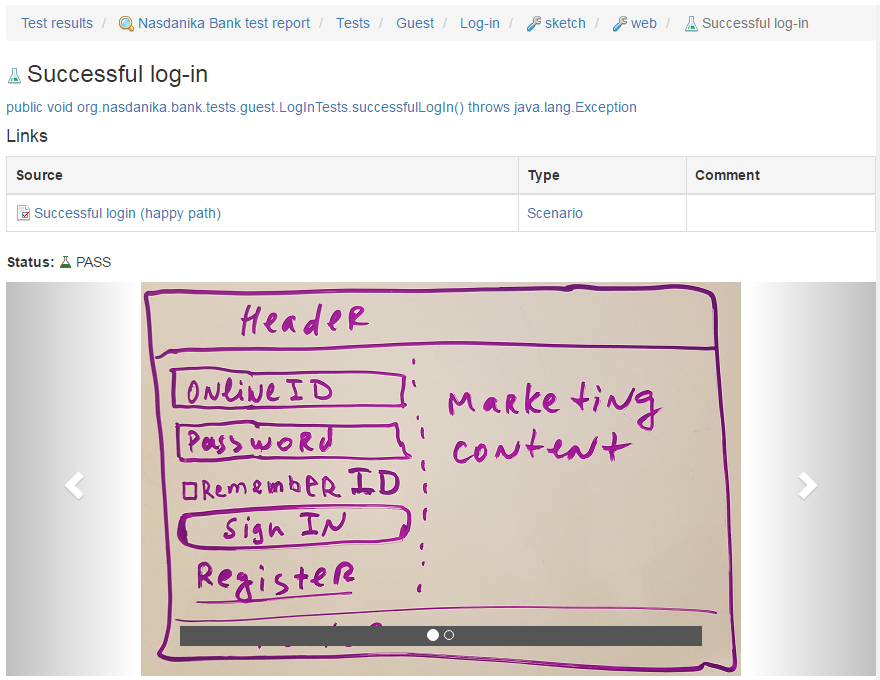
This time the result has a carousel with screenshots, which are actually our sketches. Currently there are two "screenshots" - before (above) and after the test:
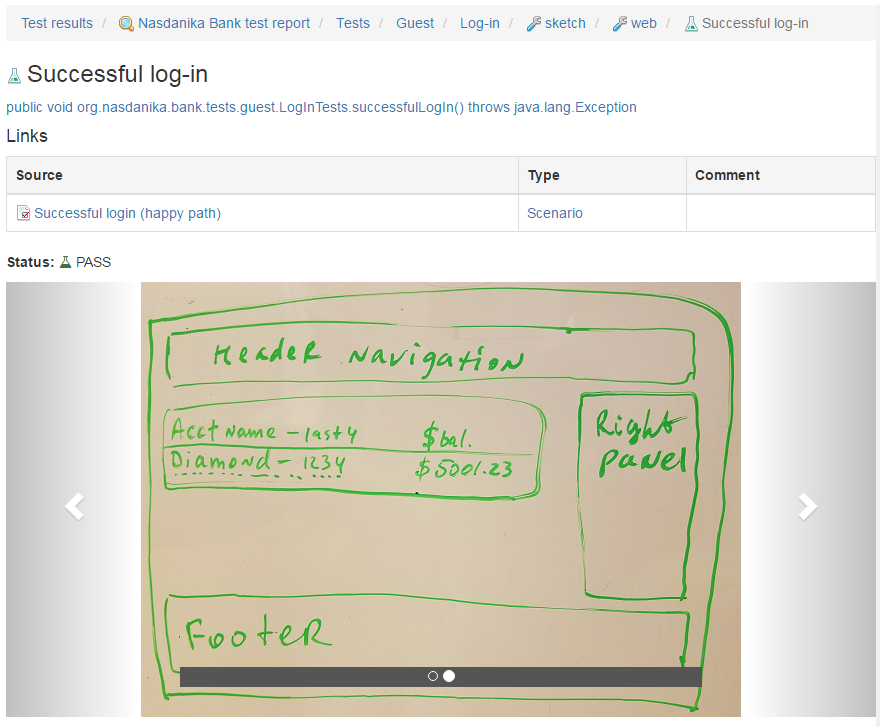
Link to a scenario
If we click on the "Successful login (happy path)" scenario link, we will see that now the scenario has two linked tests with the same name and parameter values in parentheses:
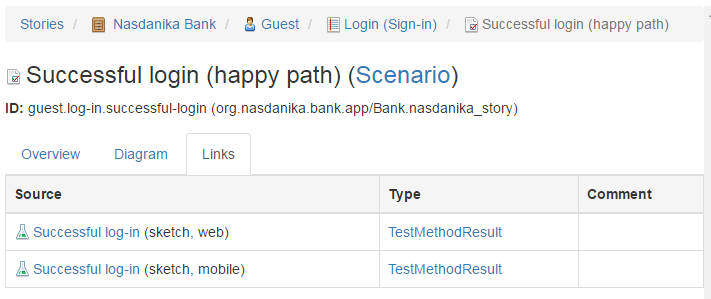
Summary
In this section we have laid the foundation for gradually evolving our tests to support progressive continuous elaboration of user experience.
In subsequent sections we will create the UI driver and provide implementations of test methods using UI driver API's.
Then we will create wireframes and mockup screens based on the sketches. Test results will show them side-by-side in order to demonstrate to the stakeholders that, say, a wireframe is an elaboration of a corresponding sketch, and not something completely different.